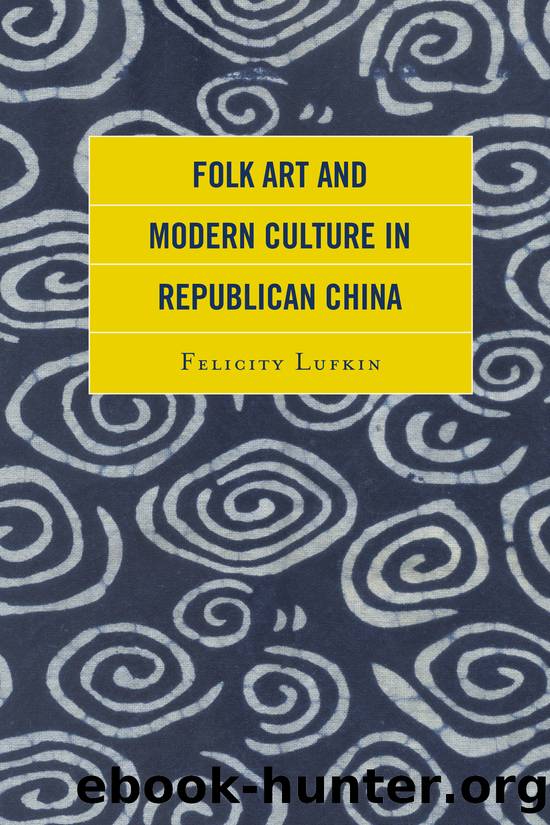Folk Art and Modern Culture in Republican China by Lufkin Felicity;

Author:Lufkin, Felicity;
Language: eng
Format: epub
Publisher: Lexington Books/Fortress Academic
Part II
FOLK ART AND PROPAGANDA IN THE ANTI-JAPANESE WAR
Chapter 5
Resistance Door Gods in the Nationalist Areas
The Japanese invasion of China, so long feared, disrupted and relocated Chinese culture, uprooting both individuals and institutions. The war changed the circumstances and contexts in which Chinese artists and critics worked and in which audiences saw art; it changed the very nature of the audience. In these new and difficult circumstances, the question of artistic popularization took on a new urgency: Ideally, artists would aid in Chinaâs struggle by using their art to raise morale, foster unity and patriotism, convey information, and arouse viewers to action. However, to fulfill these tasks, artists had to make works that appealed to broad and diverse audiences.
Even prior to the war, the notion of popularization, in a broad sense, was important to many artists and critics. As we saw in earlier chapters, when Xu Beihong praised the work of Niren Zhang, or when Sun Fuxi mused on the social place of the blue-and-white rice bowl, they were using these objects to approach issues of social class and social function in art and to help define a new sense of common Chinese heritage. When the new print movement took up the print medium, and when the Modern Print Association experimented with folk styles and subjects, they were motivated in part by the ideal of popularization. When Zhong Jingwen and Shi Shizhen organized the Folk Picture Exhibition, it was not simply an effort to archive a then little-studied cultural form but an attempt to gain better and more productive access to the both the prints and their intended audiences, in order to facilitate communication, education, and social integration.
These artists and critics, however, were working, for the most part, toward a popularization of Chinese culture that would be realized in an indefinite future; and any enthusiasm for folk art as a model for popularization was dampened by its association with âsuperstitiousâ practices and âprimitiveâ ways of life. During the war, artists sought more immediate results, and their desire to produce effective, accessible, and emotionally resonant images made more artists willing to try drawing elements from folk art. Artists and propagandists in both the Communist- and Nationalist-held areas drew on popular prints and other folk forms in their wartime work. (So did propagandists with the Japanese occupation, although that story is beyond the scope of this work.)1
The folk-inspired art of the Communist base areas is better known. Compared with folk-inspired art in the Nationalist-held areas, it was developed more systematically and was more fully integrated with the Communistsâ overall programs of propaganda and communication. However, as scholars such as David Holm and Ellen Laing have already noted, the borrowing or reworking of folk forms was not unique to the Communist base areas and did not originate there. Artists working in the Nationalist areas began making images drawing on folk traditions quite early in the war, well before Yanâanâs cultural authorities endorsed the practice.2 In his study of wartime popular culture, Chang-tai Hung
Download
This site does not store any files on its server. We only index and link to content provided by other sites. Please contact the content providers to delete copyright contents if any and email us, we'll remove relevant links or contents immediately.
On Writing A Memoir of the Craft by Stephen King(4222)
The Doodle Revolution by Sunni Brown(4052)
A Simplified Life by Emily Ley(3581)
Mummy Knew by Lisa James(3174)
Marijuana Grower's Handbook by Ed Rosenthal(3126)
Paper Parties by Erin Hung(3046)
Better Homes and Gardens New Cookbook by Better Homes & Gardens(2963)
Figure Drawing for Artists by Steve Huston(2804)
Draw Your Day by Samantha Dion Baker(2715)
The Genius of Japanese Carpentry by Azby Brown(2616)
Japanese Design by Patricia J. Graham(2562)
Lions and Lace by Meagan Mckinney(2496)
Dangerous Girls by Haas Abigail(2481)
The Curated Closet by Anuschka Rees(2393)
Zero to Make by David Lang(2349)
How to Make Your Own Soap by Sally Hornsey(2345)
The Wardrobe Wakeup by Lois Joy Johnson(2238)
The Code Book by Simon Singh(2219)
The Checklist Manifesto by Atul Gawande(2208)
